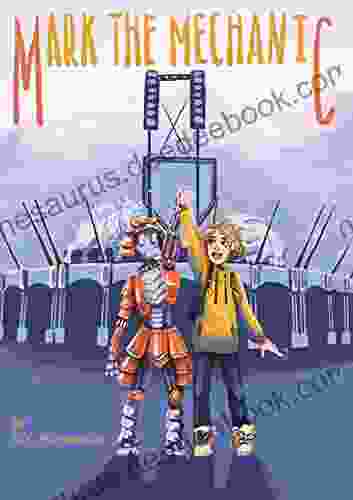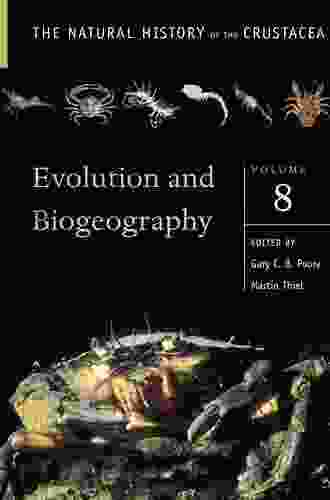Volume: The Natural History of the Crustacea

Volume: The Natural History of the Crustacea is a comprehensive and authoritative work on the natural history of crustaceans, covering their anatomy, physiology, development, behavior, and ecology.
5 out of 5
| Language | : | English |
| File size | : | 71132 KB |
| Text-to-Speech | : | Enabled |
| Screen Reader | : | Supported |
| Enhanced typesetting | : | Enabled |
| Print length | : | 554 pages |
| Lending | : | Enabled |
| X-Ray for textbooks | : | Enabled |
The book is divided into three parts. The first part covers the general anatomy and physiology of crustaceans, including their body structure, integument, nervous system, digestive system, circulatory system, respiratory system, and reproductive system.
The second part of the book covers the development of crustaceans, from their early embryonic stages to their adult forms. This section includes detailed descriptions of the different larval stages of crustaceans, as well as their metamorphosis into adults.
The third part of the book covers the behavior and ecology of crustaceans. This section includes discussions of their feeding habits, their social interactions, and their habitat preferences. The book also includes a detailed discussion of the importance of crustaceans in the marine ecosystem.
Volume: The Natural History of the Crustacea is a valuable resource for anyone interested in the study of crustaceans. It is a comprehensive and authoritative work that provides a wealth of information on the anatomy, physiology, development, behavior, and ecology of these fascinating creatures.
Anatomy and Physiology
Crustaceans are a diverse group of arthropods that includes lobsters, crabs, shrimp, and barnacles. They are characterized by their jointed appendages and their hard exoskeletons. Crustaceans are found in all aquatic habitats, from freshwater to the deep sea.
The body of a crustacean is divided into two main regions: the cephalothorax and the abdomen. The cephalothorax is the anterior region of the body and it contains the head and the thorax. The abdomen is the posterior region of the body and it contains the abdomen and the tail.
The head of a crustacean is made up of five segments. The first segment is the protocephalon, which contains the brain and the eyes. The second segment is the deutocephalon, which contains the antennae and the mandibles. The third segment is the tritocerebron, which contains the mouth and the labrum. The fourth segment is the maxillula, which contains the maxillae. The fifth segment is the maxilla, which contains the maxillipeds.
The thorax of a crustacean is made up of eight segments. The first segment is the pereon, which contains the pereiopods. The second segment is the pleon, which contains the pleopods. The third segment is the urosome, which contains the uropods. The fourth segment is the telson, which contains the anus.
The abdomen of a crustacean is made up of six segments. The first segment is the proctodeum, which contains the digestive system. The second segment is the opisthosoma, which contains the reproductive system. The third segment is the postabdomen, which contains the tail fan.
Crustaceans have a hard exoskeleton that protects their bodies from predators. The exoskeleton is made up of a complex mixture of proteins, carbohydrates, and minerals. The exoskeleton is shed periodically as the crustacean grows.
Crustaceans have a complex circulatory system. The heart is located in the thorax and it pumps blood through a series of arteries and veins. The blood of crustaceans contains a protein called hemocyanin, which is responsible for transporting oxygen throughout the body.
Crustaceans have a well-developed respiratory system. The gills are located on the thoracic appendages and they exchange oxygen and carbon dioxide with the surrounding water. Crustaceans can also breathe through their skin.
Crustaceans have a complex digestive system. The food is ingested through the mouth and it is then passed into the stomach. The stomach is lined with a series of glands that produce digestive enzymes. The food is then passed into the intestine, where it is absorbed into the bloodstream.
Crustaceans have a complex nervous system. The brain is located in the head and it is responsible for coordinating the activities of the body. The nervous system is made up of a series of nerves that run throughout the body.
Crustaceans have a complex reproductive system. The males produce sperm, which is stored in the seminal vesicles. The females produce eggs, which are stored in the ovaries. The eggs are fertilized by the sperm when they are released into the water.
Development
Crustaceans undergo a complex series of developmental stages before they reach their adult form. The first stage is the egg stage. The eggs are laid by the female and they are fertilized by the sperm. The eggs hatch into larvae, which are called nauplii. The nauplii are free-swimming and they feed on plankton.
The nauplii molt several times and they eventually develop into juvenile crustaceans. The juvenile crustaceans resemble the adult form, but they are smaller and they have not yet reached sexual maturity. The juvenile crustaceans molt several times and they eventually reach their adult form.
Behavior and Ecology
Crustaceans are a diverse group of animals that exhibit a wide range of behaviors and ecological adaptations. Crustaceans are found in all aquatic habitats, from freshwater to the deep sea. They are also found in a variety of terrestrial habitats, such as forests and deserts.
Crustaceans are generally omnivorous and they feed on a variety of plants and animals. Some crustaceans are also scavengers and they feed on dead animals. Crustaceans are an important part of the marine ecosystem and they play a role in the food chain.
Crustaceans are social animals and they often live in groups. Crustaceans communicate with each other using a variety of signals, such as pheromones and body language. Crustaceans also use their antennae to communicate with each other.
Crustaceans are an important part of the marine ecosystem and they play a role in the food chain. Crustaceans are also used as a food source by humans and they are also used in a variety of commercial products, such as chitin and
5 out of 5
| Language | : | English |
| File size | : | 71132 KB |
| Text-to-Speech | : | Enabled |
| Screen Reader | : | Supported |
| Enhanced typesetting | : | Enabled |
| Print length | : | 554 pages |
| Lending | : | Enabled |
| X-Ray for textbooks | : | Enabled |
Do you want to contribute by writing guest posts on this blog?
Please contact us and send us a resume of previous articles that you have written.
 Book
Book Page
Page Chapter
Chapter Text
Text Reader
Reader E-book
E-book Magazine
Magazine Paragraph
Paragraph Sentence
Sentence Bookmark
Bookmark Foreword
Foreword Preface
Preface Synopsis
Synopsis Annotation
Annotation Footnote
Footnote Manuscript
Manuscript Scroll
Scroll Codex
Codex Bestseller
Bestseller Biography
Biography Reference
Reference Encyclopedia
Encyclopedia Dictionary
Dictionary Narrator
Narrator Character
Character Librarian
Librarian Catalog
Catalog Card Catalog
Card Catalog Borrowing
Borrowing Stacks
Stacks Study
Study Scholarly
Scholarly Reserve
Reserve Academic
Academic Journals
Journals Interlibrary
Interlibrary Study Group
Study Group Dissertation
Dissertation Book Club
Book Club Theory
Theory Alex Sumner
Alex Sumner Chaconia J Agyenkwah
Chaconia J Agyenkwah Rob Shorland Ball
Rob Shorland Ball Dennis R Shealy
Dennis R Shealy Sharon Barnes
Sharon Barnes William Clare Roberts
William Clare Roberts Helen Hunt Jackson
Helen Hunt Jackson Alex Thomas Davis
Alex Thomas Davis Rakesh Dandu
Rakesh Dandu Yao Ma
Yao Ma Alex Myers
Alex Myers Rachel Wells
Rachel Wells James C Kearney
James C Kearney Mary Carolyn Waldrep
Mary Carolyn Waldrep Winston S Churchill
Winston S Churchill Jill B
Jill B Odette Stone
Odette Stone Starr M D
Starr M D Vigdis Hjorth
Vigdis Hjorth David Boe
David Boe
Light bulbAdvertise smarter! Our strategic ad space ensures maximum exposure. Reserve your spot today!

 Dwayne MitchellLiving and Working in London: A Comprehensive Guide to the Vibrant Metropolis
Dwayne MitchellLiving and Working in London: A Comprehensive Guide to the Vibrant Metropolis Orson Scott CardFollow ·15.9k
Orson Scott CardFollow ·15.9k Howard BlairFollow ·5.7k
Howard BlairFollow ·5.7k Robert HeinleinFollow ·12.6k
Robert HeinleinFollow ·12.6k Mikhail BulgakovFollow ·16k
Mikhail BulgakovFollow ·16k Josh CarterFollow ·3.9k
Josh CarterFollow ·3.9k W. Somerset MaughamFollow ·15.8k
W. Somerset MaughamFollow ·15.8k Brody PowellFollow ·13.4k
Brody PowellFollow ·13.4k Nathan ReedFollow ·16.7k
Nathan ReedFollow ·16.7k

 Gary Reed
Gary ReedWeb to Web for Beginners: A Comprehensive Guide to...
In today's interconnected world, websites...

 Elliott Carter
Elliott CarterThe Moon Is Down: John Steinbeck's Poignant Portrait of...
In the annals of literature, John...

 Dalton Foster
Dalton FosterMark The Mechanic: The Incredible Story Of A Young...
In the vibrant realm of robotics, where...

 Fred Foster
Fred FosteriPhone 13 Pro Max User Guide: Everything You Need to Know
The iPhone 13 Pro Max...

 Rodney Parker
Rodney ParkerPope John Paul II: The Pocket Giant Who Inspired Millions
Pope John Paul II, or...
5 out of 5
| Language | : | English |
| File size | : | 71132 KB |
| Text-to-Speech | : | Enabled |
| Screen Reader | : | Supported |
| Enhanced typesetting | : | Enabled |
| Print length | : | 554 pages |
| Lending | : | Enabled |
| X-Ray for textbooks | : | Enabled |












